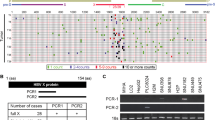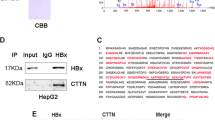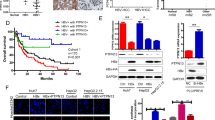Abstract
Chronic infection by hepatitis C virus (HCV) is a major risk factor for the onset and development of hepatocellular carcinoma (HCC), although the underlying mechanisms are unclear. The c-Myc oncogene contributes to the genesis of many types of cancers, including HCC, partly via the induction of genetic damage and the inhibition of the cellular response to genotoxic stress. Here, we show a previously undiscovered mechanistic link between HCV infection and enhanced c-Myc expression. c-Myc expression was augmented in non-tumoral liver tissues from HCV-infected individuals with or without HCC and in hepatocyte cell lines harboring an HCV replicon and the infectious HCV strain JFH1. Increased c-Myc expression was confirmed in vivo in a transgenic murine model expressing the entire HCV open reading frame, demonstrating a direct role for HCV protein expression in c-Myc induction. Mechanistically, activation of Akt by the HCV non-structural protein NS5A, and the subsequent stabilization of the transcription factor β-catenin, was demonstrated to be responsible for activation of the c-Myc promoter, and for increased c-Myc transcription. β-Catenin-dependent c-Myc expression in this context led to increased production of reactive oxygen species, mitochondrial perturbation, enhanced DNA damage and aberrant cell-cycle arrest. Together, these data provide a novel insight into the mechanisms involved in HCV-associated HCCs, strongly suggesting that c-Myc has a crucial contributory role in this process.
This is a preview of subscription content, access via your institution
Access options
Subscribe to this journal
Receive 50 print issues and online access
$259.00 per year
only $5.18 per issue
Buy this article
- Purchase on Springer Link
- Instant access to full article PDF
Prices may be subject to local taxes which are calculated during checkout







Similar content being viewed by others
References
Stewart BW, Kleihues P (eds) World Cancer Report. IARC Press, Lyon, 2003.
Simonetti RG, Camma C, Fiorello F, Cottone M, Rapicetta M, Marino L et al. Hepatitis C virus infection as a risk factor for hepatocellular carcinoma in patients with cirrhosis. A case-control study. Ann Intern Med 1992; 116: 97–102.
Saito I, Miyamura T, Ohbayashi A, Harada H, Katayama T, Kikuchi S et al. Hepatitis C virus infection is associated with the development of hepatocellular carcinoma. Proc Natl Acad Sci USA 1990; 87: 6547–6549.
El-Serag HB . Hepatocellular carcinoma and hepatitis C in the United States. Hepatology 2002; 36 (Suppl 1): S74–S83.
Nordenstedt H, White DL, El-Serag HB . The changing pattern of epidemiology in hepatocellular carcinoma. Dig Liver Dis 2010; 42 (Suppl 3): S206–S214.
McGivern DR, Lemon SM . Tumor suppressors, chromosomal instability, and hepatitis C virus-associated liver cancer. Annu Rev Pathol 2009; 4: 399–415.
McGivern DR, Lemon SM . Virus-specific mechanisms of carcinogenesis in hepatitis C virus associated liver cancer. Oncogene 2011; 30: 1969–1983.
Meuleman P, Leroux-Roels G . The human liver-uPA-SCID mouse: a model for the evaluation of antiviral compounds against HBV and HCV. Antiviral Res 2008; 80: 231–238.
Lerat H, Higgs MR, Pawlotsky JM . Animal models in the study of hepatitis C virus-associated liver pathologies. Expert Rev Gastroenterol Hepatol 2011; 5: 341–352.
Lerat H, Honda M, Beard MR, Loesch K, Sun J, Yang Y et al. Steatosis and liver cancer in transgenic mice expressing the structural and nonstructural proteins of hepatitis C virus. Gastroenterology 2002; 122: 352–365.
Keasler VV, Lerat H, Madden CR, Finegold MJ, McGarvey MJ, Mohammed EM et al. Increased liver pathology in hepatitis C virus transgenic mice expressing the hepatitis B virus X protein. Virology 2006; 347: 466–475.
Disson O, Haouzi D, Desagher S, Loesch K, Hahne M, Kremer EJ et al. Impaired clearance of virus-infected hepatocytes in transgenic mice expressing the hepatitis C virus polyprotein. Gastroenterology 2004; 126: 859–872.
Simonin Y, Disson O, Lerat H, Antoine E, Biname F, Rosenberg AR et al. Calpain activation by hepatitis C virus proteins inhibits the extrinsic apoptotic signaling pathway. Hepatology 2009; 50: 1370–1379.
Higgs MR, Lerat H, Pawlotsky JM . Downregulation of Gadd45beta expression by hepatitis C virus leads to defective cell cycle arrest. Cancer Res 2010; 70: 4901–4911.
Machida K, Cheng KT-H, Lai C-K, Jeng K-S, Sung VM-H, Lai MMC . Hepatitis C virus triggers mitochondrial permeability transition with production of reactive oxygen species, leading to DNA damage and STAT3 activation. J Virol 2006; 80: 7199–7207.
Farinati F, Cardin R, Bortolami M, Burra P, Russo F, Rugge M et al. Hepatitis C virus: from oxygen free radicals to hepatocellular carcinoma. J Viral Hepat 2007; 14: 821–829.
Nishina S, Hino K, Korenaga M, Vecchi C, Pietrangelo A, Mizukami Y et al. Hepatitis C virus-induced reactive oxygen species raise hepatic iron level in mice by reducing hepcidin transcription. Gastroenterology 2008; 134: 226–238.
Kato J, Kobune M, Nakamura T, Kuroiwa G, Takada K, Takimoto R et al. Normalization of elevated hepatic 8-hydroxy-2′-deoxyguanosine levels in chronic hepatitis C patients by phlebotomy and low iron diet. Cancer Res 2001; 61: 8697–8702.
Vafa O, Wade M, Kern S, Beeche M, Pandita TK, Hampton GM et al. c-Myc can induce DNA damage, increase reactive oxygen species, and mitigate p53 function: a mechanism for oncogene-induced genetic instability. Mol Cell 2002; 9: 1031–1044.
Karlsson A, Deb-Basu D, Cherry A, Turner S, Ford J, Felsher DW . Defective double-strand DNA break repair and chromosomal translocations by Myc overexpression. Proc Natl Acad Sci USA 2003; 100: 9974–9979.
Dang CV, Li F, Lee LA . Could Myc induction of mitochondrial biogenesis be linked to ROS production and genomic instability? Cell Cycle 2005; 4: 1465–1466.
Ray S, Atkuri KR, Deb-Basu D, Adler AS, Chang HY, Herzenberg LA et al. Myc can induce DNA breaks in vivo and in vitro independent of reactive oxygen species. Cancer Res 2006; 66: 6598–6605.
Sagun KC, Carcamo JM, Golde DW . Antioxidants prevent oxidative DNA damage and cellular transformation elicited by the over-expression of c-Myc. Mutat Res 2006; 593: 64–79.
Graves JA, Metukuri M, Scott D, Rothermund K, Prochownik EV . Regulation of reactive oxygen species homeostasis by peroxiredoxins and c-Myc. J Biol Chem 2009; 284: 6520–6529.
Yu L, Hitchler MJ, Sun W, Sarsour EH, Goswami PC, Klingelhutz AJ et al. AP-2alpha inhibits c-Myc induced oxidative stress and apoptosis in HaCaT human keratinocytes. J Oncol 2009; 2009: 780874.
Gan FY, Gesell MS, Alousi M, Luk GD . Analysis of ODC and c-Myc gene expression in hepatocellular carcinoma by in situ hybridization and immunohistochemistry. J Histochem Cytochem 1993; 41: 1185–1196.
Saegusa M, Takano Y, Kishimoto H, Wakabayashi G, Nohga K, Okudaira M . Comparative analysis of p53 and c-myc expression and cell proliferation in human hepatocellular carcinomas-an enhanced immunohistochemical approach. J Cancer Res Clin Oncol 1993; 119: 737–744.
Abou-Elella A, Gramlich T, Fritsch C, Gansler T . c-Myc amplification in hepatocellular carcinoma predicts unfavorable prognosis. Mod Pathol 1996; 9: 95–98.
Kawate S, Fukusato T, Ohwada S, Watanuki A, Morishita Y . Amplification of c-Myc in hepatocellular carcinoma: correlation with clinicopathologic features, proliferative activity and p53 overexpression. Oncology 1999; 57: 157–163.
Meyer N, Penn LZ . Reflecting on 25 years with Myc. Nat Rev Cancer 2008; 8: 976–990.
Prochownik EV, Li Y . The ever expanding role for c-Myc in promoting genomic instability. Cell Cycle 2007; 6: 1024–1029.
Neiman PE, Elsaesser K, Loring G, Kimmel R . Myc oncogene-induced genomic instability: DNA palindromes in bursal lymphomagenesis. PLoS Genet 2008; 4: e1000132.
Menssen A, Epanchintsev A, Lodygin D, Rezaei N, Jung P, Verdoodt B et al. c-Myc delays prometaphase by direct transactivation of MAD2 and BubR1: identification of mechanisms underlying c-Myc-induced DNA damage and chromosomal instability. Cell Cycle 2007; 6: 339–352.
Herold S, Wanzel M, Beuger V, Frohme C, Beul D, Hillukkala T et al. Negative regulation of the mammalian UV response by Myc through association with Miz-1. Mol Cell 2002; 10: 509–521.
Wierstra I, Alves J . The c-Myc promoter: still MysterY and challenge. Adv Cancer Res 2008; 99: 113–333.
He TC, Sparks AB, Rago C, Hermeking H, Zawel L, da Costa LT et al. Identification of c-Myc as a target of the APC pathway. Science 1998; 281: 1509–1512.
Tetsu O, McCormick F . Beta-catenin regulates expression of cyclin D1 in colon carcinoma cells. Nature 1999; 398: 422–426.
He Y, Nakao H, Tan SL, Polyak SJ, Neddermann P, Vijaysri S et al. Subversion of cell signaling pathways by hepatitis C virus nonstructural 5A protein via interaction with Grb2 and P85 phosphatidylinositol 3-kinase. J Virol 2002; 76: 9207–9217.
Street A, Macdonald A, Crowder K, Harris M . The hepatitis C virus NS5A protein activates a phosphoinositide 3-kinase-dependent survival signaling cascade. J Biol Chem 2004; 279: 12232–12241.
Street A, Macdonald A, McCormick C, Harris M . Hepatitis C virus NS5A-mediated activation of phosphoinositide 3-kinase results in stabilization of cellular beta-catenin and stimulation of beta-catenin-responsive transcription. J Virol 2005; 79: 5006–5016.
Park CY, Choi SH, Kang SM, Kang JI, Ahn BY, Kim H et al. Nonstructural 5A protein activates beta-catenin signaling cascades: implication of hepatitis C virus-induced liver pathogenesis. J Hepatol 2009; 51: 853–864.
Milward A, Mankouri J, Harris M . Hepatitis C virus NS5A protein interacts with beta-catenin and stimulates its transcriptional activity in a phosphoinositide-3 kinase-dependent fashion. J Gen Virol 2010; 91: 373–381.
Boyault S, Rickman DS, de Reynies A, Balabaud C, Rebouissou S, Jeannot E et al. Transcriptome classification of HCC is related to gene alterations and to new therapeutic targets. Hepatology 2007; 45: 42–52.
Legoix P, Bluteau O, Bayer J, Perret C, Balabaud C, Belghiti J et al. Beta-catenin mutations in hepatocellular carcinoma correlate with a low rate of loss of heterozygosity. Oncogene 1999; 18: 4044–4046.
Laurent-Puig P, Legoix P, Bluteau O, Belghiti J, Franco D, Binot F et al. Genetic alterations associated with hepatocellular carcinomas define distinct pathways of hepatocarcinogenesis. Gastroenterology 2001; 120: 1763–1773.
Schuhmacher M, Kohlhuber F, Holzel M, Kaiser C, Burtscher H, Jarsch M et al. The transcriptional program of a human B cell line in response to Myc. Nucleic Acids Res 2001; 29: 397–406.
Li F, Wang Y, Zeller KI, Potter JJ, Wonsey DR, O'Donnell KA et al. Myc stimulates nuclearly encoded mitochondrial genes and mitochondrial biogenesis. Mol Cell Biol 2005; 25: 6225–6234.
Kim J, Lee JH, Iyer VR . Global identification of Myc target genes reveals its direct role in mitochondrial biogenesis and its E-box usage in vivo. PLoS ONE 2008; 3: e1798.
Mitchell C, Robin MA, Mayeuf A, Mahrouf-Yorgov M, Mansouri A, Hamard M et al. Protection against hepatocyte mitochondrial dysfunction delays fibrosis progression in mice. Am J Pathol 2009; 175: 1929–1937.
Menssen A, Hermeking H . Characterization of the c-Myc-regulated transcriptome by SAGE: identification and analysis of c-Myc target genes. Proc Natl Acad Sci USA 2002; 99: 6274–6279.
Ray RB, Lagging LM, Meyer K, Steele R, Ray R . Transcriptional regulation of cellular and viral promoters by the hepatitis C virus core protein. Virus Res 1995; 37: 209–220.
Hsieh A, Kim HS, Lim SO, Yu DY, Jung G . Hepatitis B viral X protein interacts with tumor suppressor adenomatous polyposis coli to activate Wnt/beta-catenin signaling. Cancer Lett 2011; 300: 162–172.
Zucman-Rossi J . Human and mouse hepatocellular adenoma and carcinoma display similar tumorigenesis pathway alterations. J Hepatol 2008; 48: 884–886.
Zhang Y, Wei W, Cheng N, Wang K, Li B, Jiang X et al. Hepatitis C virus-induced upregulation of miR-155 promotes hepatocarcinogenesis by activating Wnt signaling. Hepatology 2012, (in press).
Si Y, Liu X, Cheng M, Wang M, Gong Q, Yang Y et al. Growth differentiation factor 15 is induced by hepatitis C virus infection and regulates hepatocellular carcinoma-related genes. PLoS ONE 2011; 6: e19967.
Cadoret A, Ovejero C, Saadi-Kheddouci S, Souil E, Fabre M, Romagnolo B et al. Hepatomegaly in transgenic mice expressing an oncogenic form of beta-catenin. Cancer Res 2001; 61: 3245–3249.
Garcia-Mediavilla MV, Sanchez-Campos S, Gonzalez-Perez P, Gomez-Gonzalo M, Majano PL, Lopez-Cabrera M et al. Differential contribution of hepatitis C virus NS5A and core proteins to the induction of oxidative and nitrosative stress in human hepatocyte-derived cells. J Hepatol 2005; 43: 606–613.
Korenaga M, Wang T, Li Y, Showalter LA, Chan T, Sun J et al. Hepatitis C virus core protein inhibits mitochondrial electron transport and increases reactive oxygen species (ROS) production. J Biol Chem 2005; 280: 37481–37488.
Li Y, Boehning DF, Qian T, Popov VL, Weinman SA . Hepatitis C virus core protein increases mitochondrial ROS production by stimulation of Ca2+ uniporter activity. FASEB J 2007; 21: 2474–2485.
Yochum GS, McWeeney S, Rajaraman V, Cleland R, Peters S, Goodman RH . Serial analysis of chromatin occupancy identifies beta-catenin target genes in colorectal carcinoma cells. Proc Natl Acad Sci USA 2007; 104: 3324–3329.
Semenov MV, Tamai K, Brott BK, Kuhl M, Sokol S, He X . Head inducer Dickkopf-1 is a ligand for Wnt coreceptor LRP6. Curr Biol 2001; 11: 951–961.
Acknowledgements
This work was supported by a research grant from the Agence Nationale de Recherche sur le SIDA et les Hépatites Virales (ANRS). MH was supported by a postdoctoral fellowship from the ANRS. We thank Aurore Gaudin and Olivier Gouin for technical assistance; Christine Perret and Thomas Decaens for manuscript comments; Czeslaw Wychowski, Bert Vogelstein and Xi He for JFH-1-infected cultures, pDEL1 and DKK1, respectively; Mark Harris for the NS5A antibody; Paulette Bioulac-Sage for patient biopsies; and Ralf Bartenschlager for the HCV genotype 1b subgenomic replicon, established in our laboratory by Abdelhakim Ahmed-Belkacem.
Author information
Authors and Affiliations
Corresponding author
Ethics declarations
Competing interests
The authors declare no conflict of interest.
Additional information
Supplementary Information accompanies the paper on the Oncogene website
Rights and permissions
About this article
Cite this article
Higgs, M., Lerat, H. & Pawlotsky, JM. Hepatitis C virus-induced activation of β-catenin promotes c-Myc expression and a cascade of pro-carcinogenetic events. Oncogene 32, 4683–4693 (2013). https://doi.org/10.1038/onc.2012.484
Received:
Revised:
Accepted:
Published:
Issue Date:
DOI: https://doi.org/10.1038/onc.2012.484
Keywords
This article is cited by
-
Hepatitis C virus may accelerate breast cancer progression by increasing mutant p53 and c-Myc oncoproteins circulating levels
Breast Cancer (2024)
-
Androgen receptor variant 7 exacerbates hepatocarcinogenesis in a c-MYC-driven mouse HCC model
Oncogenesis (2023)
-
MYC in liver cancer: mechanisms and targeted therapy opportunities
Oncogene (2023)
-
Mistletoe extract Fraxini inhibits the proliferation of liver cancer by down-regulating c-Myc expression
Scientific Reports (2019)
-
Differential regulation of the Wnt/β-catenin pathway by hepatitis C virus recombinants expressing core from various genotypes
Scientific Reports (2018)



